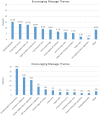Youth generated prevention messages about electronic cigarettes
- PMID: 30753438
- PMCID: PMC6424147
- DOI: 10.1093/her/cyz001
Youth generated prevention messages about electronic cigarettes
Abstract
Rates of e-cigarette use are high among youth, and there is little known about the long-term health effects of e-cigarettes. Since peer influence is a powerful determinant of tobacco use, we aimed to identify message themes about e-cigarettes that youth would use to encourage or discourage peers from using e-cigarettes. We conducted 10 focus groups (N = 69) with non-smokers and smokers from one middle school, high school and college in Connecticut. Participants engaged in a discussion about e-cigarettes, and each participant created one written message to encourage e-cigarette use and one to discourage use among peers. We content-analyzed the messages and identified three main themes and 12 encouraging and discouraging sub-themes. Encouraging themes included health benefits of e-cigarettes relative to cigarettes, attractive product characteristics (e.g. flavors) and social advantages (e.g. positive social image) of using e-cigarettes. Discouraging messages included health risks of e-cigarettes relative to cigarettes, unattractive product characteristics (e.g. cost) and social disadvantages (e.g. negative social image of using an e-cigarette). Overall, there were no differences by sex, age group or smoking status in generation of encouraging and discouraging message themes. This study identified youth-generated themes that may aid in e-cigarette prevention among youth.
� The Author(s) 2019. Published by Oxford University Press. All rights reserved. For permissions, please email: journals.permissions@oup.com.
Figures
Similar articles
-
Reasons for Electronic Cigarette Experimentation and Discontinuation Among Adolescents and Young Adults.Nicotine Tob Res. 2015 Jul;17(7):847-54. doi: 10.1093/ntr/ntu257. Epub 2014 Dec 6. Nicotine Tob Res. 2015. PMID: 25481917 Free PMC article.
-
Preference for gain- or loss-framed electronic cigarette prevention messages.Addict Behav. 2016 Nov;62:108-13. doi: 10.1016/j.addbeh.2016.06.015. Epub 2016 Jun 11. Addict Behav. 2016. PMID: 27344117 Free PMC article.
-
Psychological distress and responses to comparative risk messages about electronic and combusted cigarettes.Addict Behav. 2019 Apr;91:141-148. doi: 10.1016/j.addbeh.2018.11.025. Epub 2018 Nov 19. Addict Behav. 2019. PMID: 30477820 Free PMC article.
-
Cardiopulmonary Impact of Electronic Cigarettes and Vaping Products: A Scientific Statement From the American Heart Association.Circulation. 2023 Aug 22;148(8):703-728. doi: 10.1161/CIR.0000000000001160. Epub 2023 Jul 17. Circulation. 2023. PMID: 37458106 Review.
-
Public Health Policies on E-Cigarettes.Curr Cardiol Rep. 2019 Aug 28;21(10):111. doi: 10.1007/s11886-019-1204-y. Curr Cardiol Rep. 2019. PMID: 31463564 Free PMC article. Review.
Cited by
-
The Influence of Friends on Teen Vaping: A Mixed-Methods Approach.Int J Environ Res Public Health. 2021 Jun 24;18(13):6784. doi: 10.3390/ijerph18136784. Int J Environ Res Public Health. 2021. PMID: 34202600 Free PMC article.
-
Health Care Professionals' Clinical Skills to Address Vaping and e-Cigarette Use by Patients: Needs and Interest Questionnaire Study.JMIR Form Res. 2022 Apr 11;6(4):e32242. doi: 10.2196/32242. JMIR Form Res. 2022. PMID: 35404264 Free PMC article.
-
Identifying message content to reduce vaping: Results from online message testing trials in young adult tobacco users.Addict Behav. 2021 Apr;115:106778. doi: 10.1016/j.addbeh.2020.106778. Epub 2020 Dec 11. Addict Behav. 2021. PMID: 33341530 Free PMC article.
-
Exploring Perceptions of Anti-vaping Message Themes: A Qualitative Study of Australian Adolescents and Adults.Nicotine Tob Res. 2025 Jan 22;27(2):262-270. doi: 10.1093/ntr/ntae198. Nicotine Tob Res. 2025. PMID: 39162831 Free PMC article.
-
Reactions to electronic nicotine delivery system (ENDS) prevention messages: results from qualitative research used to inform FDA's first youth ENDS prevention campaign.Tob Control. 2020 Sep;29(5):510-515. doi: 10.1136/tobaccocontrol-2019-055104. Epub 2019 Sep 10. Tob Control. 2020. PMID: 31506379 Free PMC article.
References
-
- U.S. Department of Health and Human Services. E-cigarette use among youth and young adults. In: U. S. D. o. H. a. H. S. A. R. o. t. S. (eds). General. Atlanta, GA: Centers for Disease Control and Prevention, National Center for Chronic Disease Prevention and Health Promotion, Office on Smoking and Health, 2016.
-
- Brown EM, Henes AL, Olson LT.. E-cigarette policies on college campuses: student use behaviors, awareness, and policy support. J Community Health 2016; 41: 1110–5. - PubMed
-
- Saddleson ML, Kozlowski LT, Giovino GA. et al. Risky behaviors, e-cigarette use and susceptibility of use among college students. Drug Alcohol Depend 2015; 149: 25–30. - PubMed
-
- Flay BR, Phil D, Hu FB. et al. Psychosocial predictors of different stages of cigarette smoking among high school students. Prev Med 1998; 27: A9–18. - PubMed


